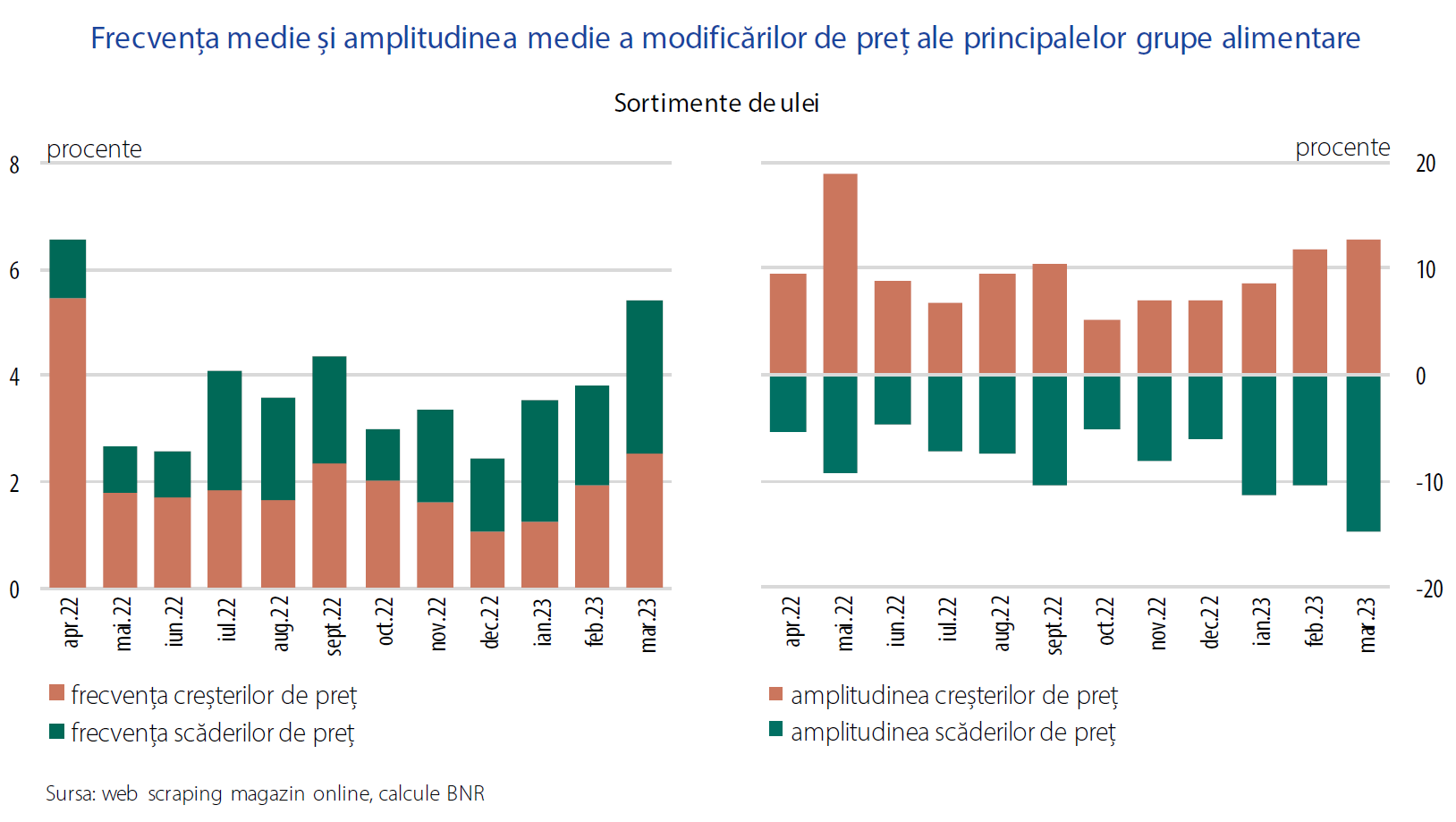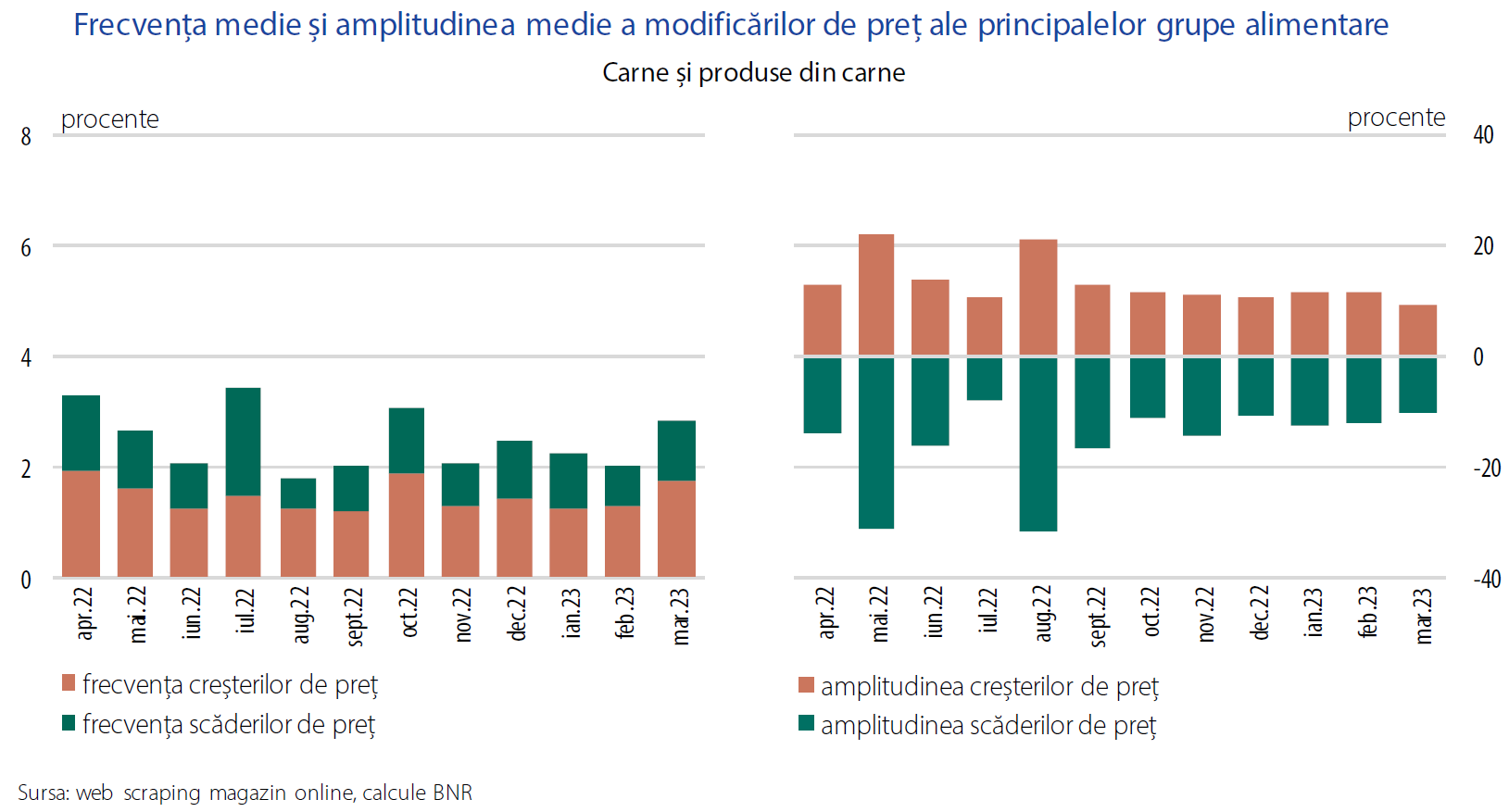
“Our goal was to investigate the extent to which spending growth from 2022 has led to flexibility in consumer prices for processed food products with a potential impact on the transmission of monetary policy actions,” Tudor Grosu, head of the Department of Macroeconomic Modeling and Forecasting, told HotNews of the Central Bank .
Detailed data on the prices of castor oil in the assortment indicate that the initial reaction of retail operators was related to the frequency of price changes, with price increases occurring more often, but not necessarily in larger sizes; at the same time, the frequency of price reductions decreased, and a slight decrease in their amplitude was also noted
The results support the idea that flexibility is only temporary and does not affect the effectiveness of monetary policy, Grosu says. The temporary nature is most obvious in oil, where the cost shock was the biggest, but a similar development took place in the case of the other two groups, the BNR official also explained to HotNews.
Price rigidity and how firms respond to various shocks affect economic activity and the transmission of monetary policy
Easing monetary conditions will stimulate demand, especially since prices will be delayed in responding to the new context. The more flexible prices are, the smaller the effect of monetary policy will be.
The NBR investigated the flexibility of food prices in the context of turbulence in commodity markets, which has been fixed since the spring of 2022, largely related to the conflict in Ukraine, observing the reaction of economic operators to a significant increase in quotations.
This attempt used a database obtained through web scraping (an automated process of extracting data from web pages that involves programming algorithms that access websites of interest, extract information, and convert it into a structured format). , which is becoming an increasingly common technique at the level of central banks.
The BNR analysis focused on food prices, daily data on prices for the main categories of consumer basket products (meat and meat products, milk and dairy products, oil varieties, bread and bakery products, sugar varieties) were collected. , vegetables, fruits), covering the period from April 1, 2022 to March 31, 2023. In total, we are talking about 4,720 products and more than 680,000 price observations.
The ratio of the number of actual price changes to the total number of observations results in a daily price change frequency of 3.2%. In other words, nearly 97% of the time, food prices remain constant from day to day, with price adjustments occurring on average about once a month.
One result shows that growth predominates and the size of price changes is large, regardless of whether it is up or down.
Almost half of the adjustments are either price reductions of more than 5.7% or price increases of more than 9.7%. Also, although increases are more common than decreases, the latter are slightly wider on average
The study was focused on three groups of goods – an assortment of oil, milk and dairy products, meat and meat products – the share of which in the consumer basket of products is significant (43% and 55%, respectively, in the basket of processed products).
The spring of 2022 was marked by a significant increase in quotations of agricultural and energy products in Romania
The spring of 2022 was marked by a significant increase in quotations of agricultural and energy products in Romania on the domestic market, in accordance with events at the international level, against the background of the beginning of the Russian-Ukrainian war, among which the two warring states of the world’s most important exporters of raw materials
A particularly significant increase in prices was recorded for oil raw materials, considering that Ukraine occupies the largest share in this market, the de-escalation of the situation occurred only with the signing of an agreement on the export of agro-food raw materials through the Black Sea in the last decade of July.

The panels to the left of the graphs show the frequency, or rather, how often price changes (higher/lower prices) occurred for the analyzed food groups, and in the panels to the right you can find the amplitude (step) corresponding to the corresponding changes.
A review of the overall distribution of price changes across oil ranges makes the April price tightening even more apparent, but it can be appreciated that the flexibility in consumer prices was temporary and the distribution resumed its normal profile in the following months.
In the case of milk and dairy products, price dynamics were somewhat more limited in the initial phase of the conflict in Ukraine, but in August-November, a significant increase in quotations was recorded against the background of rising energy and feed costs, also associated with persistent drought in the summer months, which reduced pasture area. Similarly, the retail response to these shocks was largely driven by the frequency of price increases, but price flexibility was only temporary.

As for meat and meat products, the more heterogeneous nature of the group makes it difficult to identify a shock that can significantly affect the development of the situation at the level of the entire category. Thus, the outbreak of the conflict had a greater impact on pork prices, while poultry meat on agricultural markets in the third quarter of 2022 became more expensive.
However, it can be distinguished that these two effects correspond to the intensification of the frequency of price increases in April and October, without significant changes in the amplitude of price changes in these months.

CONCLUSIONS
The present analysis, based on the collected data, shows that the response of the food retail sector to an upward cost shock is relatively quick, leading to more frequent price increases without a noticeable change in their amplitude. However, this price flexibility is temporary, suggesting that the impact of monetary policy has not been dampened by these events.
Source: Hot News
Ashley Bailey is a talented author and journalist known for her writing on trending topics. Currently working at 247 news reel, she brings readers fresh perspectives on current issues. With her well-researched and thought-provoking articles, she captures the zeitgeist and stays ahead of the latest trends. Ashley’s writing is a must-read for anyone interested in staying up-to-date with the latest developments.